The New Motorola Moto X (2nd Gen) Review
by Joshua Ho on September 17, 2014 9:00 AM EST- Posted in
- Smartphones
- Motorola
- Android
- Mobile
Display
Without question, the display is one of the most important aspects of a smartphone. Unlike desktops and laptops, smartphones are primarily interacted with through their displays. Unfortunately, it’s hard to evaluate a display by eye as human vision is strongly dependent upon context. In order to control for this aspect, we turn to SpectraCal’s CalMAN 5 with a custom workflow in order to test smartphone displays. At any rate, let’s get into the data.
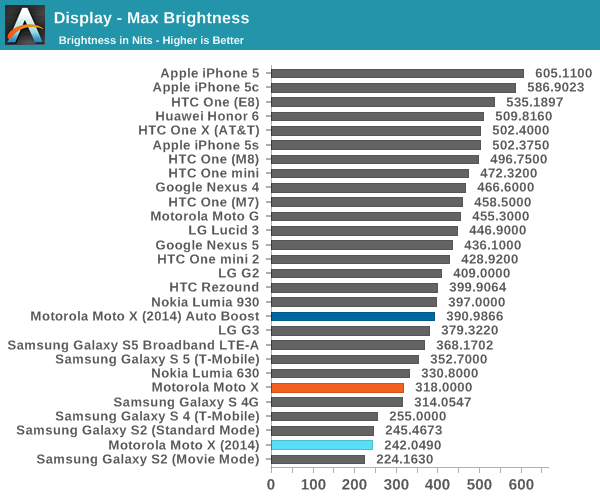
In the basics, the new Moto X is a bit on the low side. While AMOLED has traditionally struggled with luminance in situations such as the web browser and light-themed applications, Samsung’s Galaxy S5 and S5 LTE-A Broadband have shown that it’s possible to achieve levels of brightness approaching some of the brightest RGB-stripe LCDs. As the brightness of the Lumia 930 is about equal to the new Moto X, I suspect we're looking at the Galaxy S4/Note 3 generation of panels. This seems to be backed up by pictures of the subpixel layout seen below as the green subpixels seem to be noticeably larger when compared to the Galaxy S5's panel.
Contrast is still incredible, but I can still see the purple smearing effect that comes from unlit to lit pixels. I’m still unable to get a clear answer on why this is, but it’s likely that capacitance somewhere in the system is causing this issue in the form of RC delay. Whether this is a fixable issue is something I’m not aware of yet. The clear solution would be to set black to the lowest possible brightness a lit pixel can be, but this would make for worse contrast.

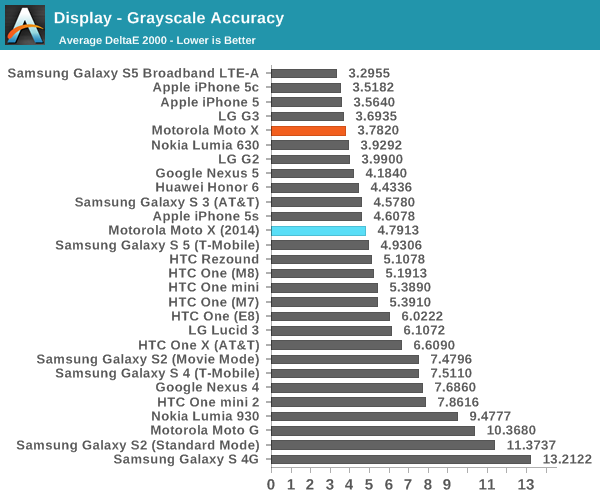
In grayscale, the new Moto X isn’t the best. We see that the display is just a bit too red, and that most of the luminance is coming from red and green. This makes sense from a power and display lifetime perspective though, as blue tends to have the least efficient emitter material in an AMOLED display. However, this translates to poor grayscale performance. The green tint tends to show itself in certain shades of grayscale as well.

In our saturation sweep, the new Moto X continues to be rather poor in its performance. While on Samsung phones it’s normal to see colors like this on the default display mode, there’s usually a mode that correctly constrains the display to sRGB which is the industry standard for displaying colors. There’s no such mode on the new Moto X, so the display significantly overshoots sRGB. This doesn’t bode well for the ColorChecker, which provides the most thorough look at color accuracy.
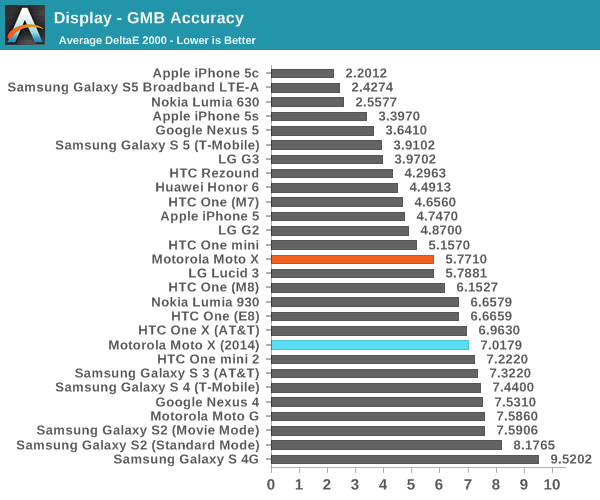
As predicted, the new Moto X does poorly in the ColorChecker. There’s really not much that the Moto X can accurately display in sRGB as just by pushing the gamut too far, even if there wasn’t saturation compression for some colors, the large gamut will cause distortion of all colors within the gamut triangle.
Unfortunately, it’s not clear where this lack of attention to color accuracy comes from. In discussions with Andrei it's clearly possible to calibrate the AMOLED panel from the GS4 quite accurately, and there's no real technical limitation for AMOLED to lack good calibration. However, judging by the relatively low peak brightness there are other issues as this could affect Motorola's performance in battery life tests. This seems to suggest that Motorola is unable to access the latest generation of AMOLED panels from Samsung Display.
This would be a rather startling thought, as it means that no matter what Motorola does to improve their implementation of Samsung’s AMOLED displays, they will always be behind the curve. If it becomes clear that Samsung’s AMOLED is the best display from a user-facing standpoint, every other OEM will face significant barriers in competition as they would be unable to access the latest generation AMOLED panels. The real solution here is for other display manufacturers such as LG, JDI, and AUO Optronics to catch up.
At any rate, the display of the new Moto X seems to be relatively poor compared to what we see in the Galaxy S5 LTE-A (and likely the Note 4), along with the iPhone 5s, Nexus 5, and One (M7). While it’s impossible to ignore the power advantage of AMOLED when implementing functions like Moto Display, the relatively low peak brightness and poor color accuracy are concerning.


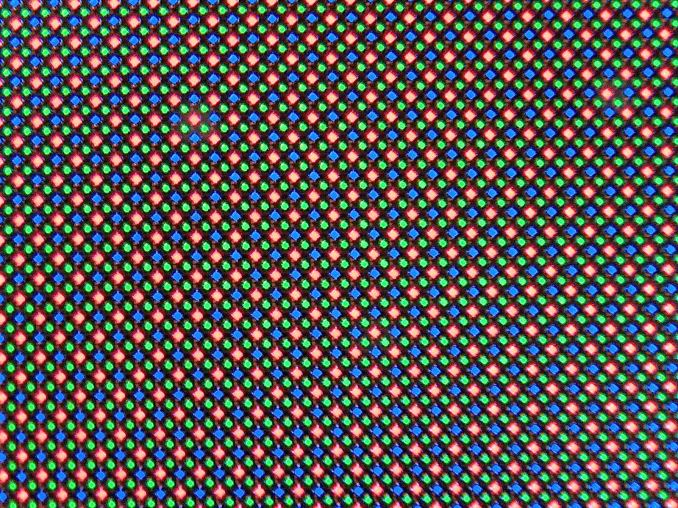

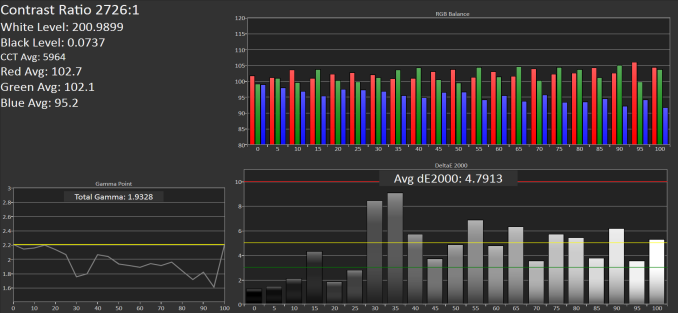

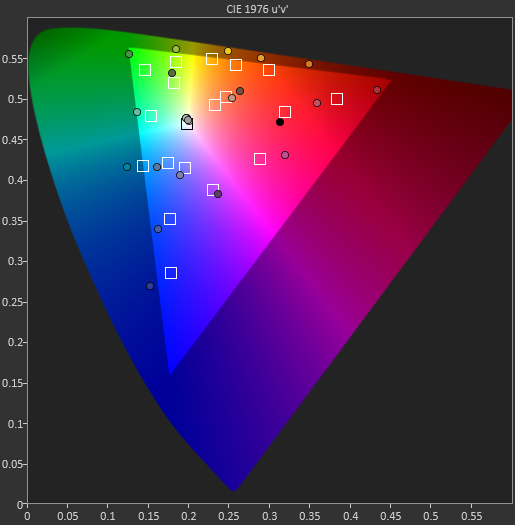








179 Comments
View All Comments
Harry_Wild - Sunday, September 21, 2014 - link
I will wait to see the new Moto X 2014 in person before deciding them. Thanks for the reply! Since the Moto X seems to be the same shape as the upcoming Nexus X; then I glad that it close the old 4.7" Moto X. A shopping we will go! LOL!gg555 - Wednesday, September 24, 2014 - link
I don't know, to me the original Moto X had a cheap plastic feel to it despite the nice sculptured back. It was a far cry for the higher quality feel of the polycarbonate material in some of the Nokia phones. I think the new design has a much higher quality feel to it, though the large size does affect how it fits in one's hand a bit.grant3 - Saturday, September 20, 2014 - link
Does this phone support 3-button android headsets? (like samsung + HTC do)Monish - Saturday, September 20, 2014 - link
Guys, is MOTO X 2nd gen OTG compatible ? I asked MOTO customer care agent, he said It is not compatible. So when i questioned him that MOTO X 1st gen had it (saw XDA forums) he further added that Motorola cannot guarantee it!OTG compatibility is the only thing stopping me from buying this phone as in INDIA you get only 16GB version.
JoshHo - Saturday, September 20, 2014 - link
USB-OTG is fully functional.Monish - Sunday, September 21, 2014 - link
Did u test it Josh ? Sorry was asking but just double checking since customer care agent said otherwise.erikiksaz - Tuesday, September 23, 2014 - link
It works, at least for USB audio. Haven't tested it with storage.raghwendra123 - Saturday, September 20, 2014 - link
A little off topic... but how come galaxy s5 top most performance benchmarks by quite a margin when it has snapdragon 801 too? And why does its T-mobile version doesn't?raghwendra123 - Sunday, September 21, 2014 - link
I mean the the Basemark ones.EdCraft - Tuesday, September 23, 2014 - link
The new moto X seems very good, much better than the ever-so-lagging-behind new iPhone. The question is though, can Motorola match up to HTC in consumer satisfaction? Motorola hasn't quite managed to do it so far (source: http://www.consumertop.com/best-phone-guide/), but this one seems very promising!